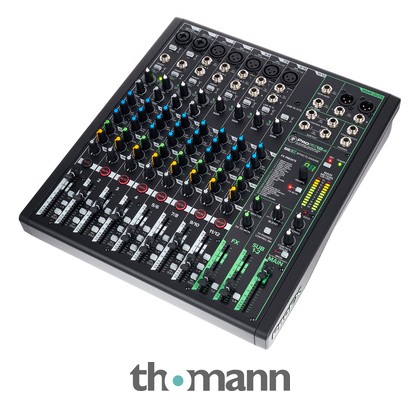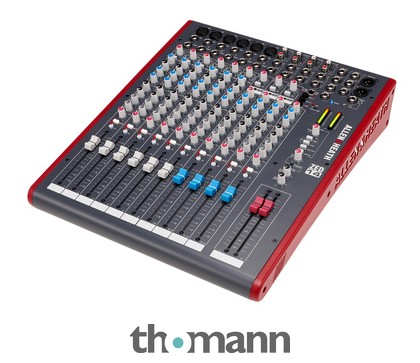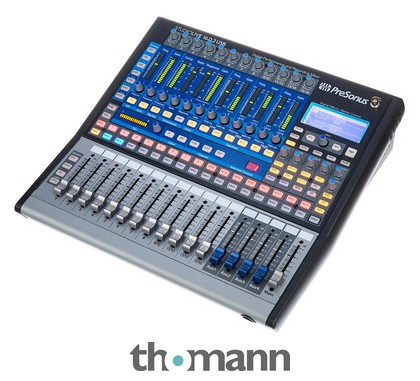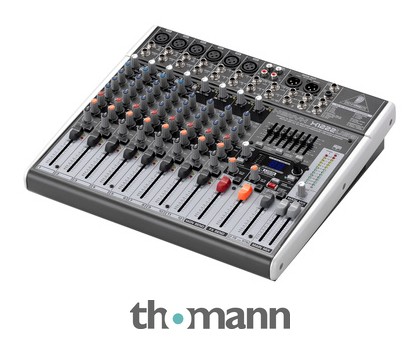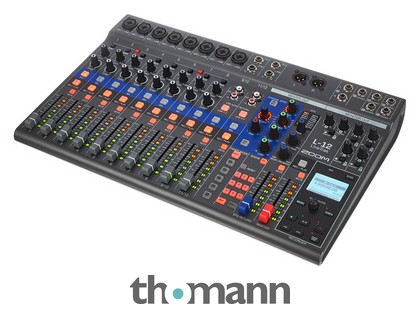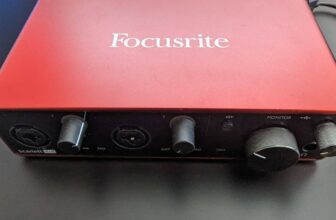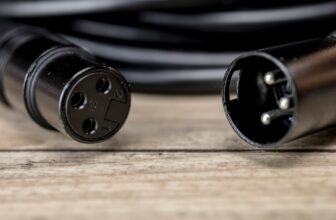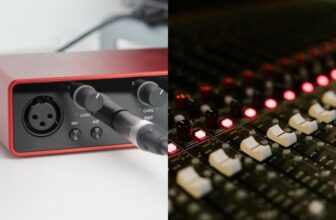The 7 Best Audio Mixers for Recording, Mastering, and Mixing (2024)
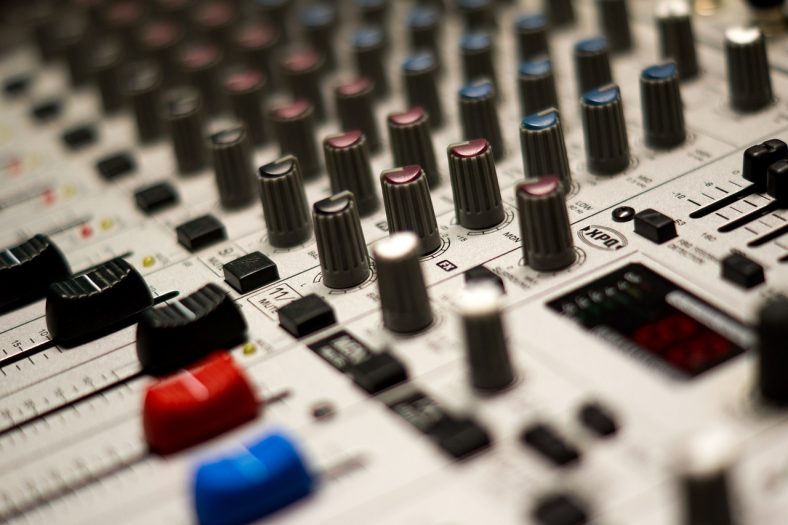
Audio mixers are essential parts of any live or recording setup. They collect audio signals from various sources blending and processing them as desired before sending them to external amplification or recording equipment.
There are many mixers on the market which can be overwhelming and confusing to choose the best one. A standard analog mixer is usually cheaper and easier to use. A digital mixer is more complicated and versatile as it converts analog signals to digital signals before processing them with a variety of features including presets, effects, automation, and other functions.
My top audio mixer recommendation is the Mackie ProFXv3 Series 12, which is a great audio mixer for the price with its portable design, and handy features.
For tighter budgets, I suggest the Behringer Xenyx X1222USB 16, an analog audio mixer with a great value for the offered price and simple yet reliable features.
Contents
- The 7 Best Audio Mixers for Recording, Mastering, and Mixing (2024)
- 1. Mackie ProFXv3 Series 12
- 2. Behringer Xenyx X1222USB 16
- 3. Allen & Heath ZED-14
- 4. Yamaha MG12XU
- 5. PreSonus StudioLive 16.0.2
- 6. Zoom LiveTrak L-12
- 7. Peavey PVi 6500
- How does an Audio Mixer work?
- What is the difference between an Audio Interface and an Audio Mixer?
- How important are built-in effects?
- How long do Audio Mixers last?
- What to look for in an Audio Mixer?
- Conclusion
The 7 Best Audio Mixers for Recording, Mastering, and Mixing (2024)
Let’s compare these in more detail.
1. Mackie ProFXv3 Series 12
Mackie ProFX v3 Series 12 is the portable 12-channel model of the popular audio mixer series. Mackie is a well-known name in the audio mixer market, with its reliable and high-quality products at relatively affordable prices. If you are after a compact yet great digital audio mixer, this one is an excellent choice.
Pros
- 2-channel USB recording
- Feature-packed with GigFx effects engine and Onyx preamps
- Compact and portable
- Great value for the price
- Comes with a good software bundle
Cons
- Doesn’t have MIDI connectivity
- More comprehensive EQ section would have been nice
It is eqıipped with 12 channels (8 mono and 1 stereo), a USB interface for dual-channel recording and playback with 24-bit, up to 192kHz sample rates, and a practical set of core features with great Onyx preamps and 24 different GigFx effects.
All the features in the lightweight and compact design make a great audio mixer for home use or a practical live mixer. As a 12-channel audio mixer, it may be a bit limited for bigger venues and setups. Also, I would have liked to have the option for MIDI connectivity and a more comprehensive EQ section.
| Number of channels | 12 (8 x mono, 1 x stereo) |
| Connectivity | USB (2 x 4) |
| Effects Engine | GigFX |
| Number Of Effects | 24 |
| Compatibility | Mac, Pc |
In short, Mackie ProFXv3 Series 12 is an ideal audio mixer for home studios as well as small live performances. It is portable and has all the core features you would need for a relatively affordable price.
2. Behringer Xenyx X1222USB 16
Behringer Xenyx X1222USB is a 12-channel analog audio mixer designed for home studios and small venue lives concerts. It is a pretty portable mixer with its compact and lightweight design and is pretty versatile for the price with its dual-engine Multi-FX processor including delay, flanger, chorus, reverb effects.
Pros
- Great value for the price
- Compact and portable
- 6 Xenyx mic preamps
- Decent sound-sculpting features
Cons
- Designed for smaller applications
- Not the greatest line of effects
The audio mixer has a good range of sound-sculpting features with a 3-band EQ for each channel and a 7-band graphic equalizer for further customization. There are 8 TRS and 2 RCA inputs, with 6 of the XLR inputs featuring Xenyx mic preamps delivering clear sound.
It does not have an extensive line of effects as digital audio mixers, as it is still a budget analog mixer.
| Number of channels | 12 |
| Connectivity | USB (2 x 2) |
| Effects Engine | Dual engine Multi-FX processor |
| Number Of Effects | 16 |
| Compatibility | Mac, Pc |
To summarize, Behringer Xenyx X1222USB 16 is a good audio mixer for home studios, podcasting projects, and small live performances to get the job done at a budget-friendly price.
3. Allen & Heath ZED-14
Allen & Heath ZED-14 is a popular audio mixer among home studios and live recording setups. It is equipped with 12-channels, 8 mono, and 4 stereo inputs, DuoPre preamps providing transparent sound, 3-band EQ on each mono channel, and 2-band EQ on each stereo channel.
Pros
- Solid build quality
- 14 inputs to work with
- DuoPre preamps sound quite good and have up to 69 dB of gain
- Big faders are easy and fun to use
- 2 pre-fade and 2-post fade AUX ports
Cons
- Audio interface fixed at 16-bit
- USB 1.1 (but USB 2 compatible)
- No EQ-bypass
ZED-14 is a well-specified analog audio mixer for the price. The XLR inputs provide phantom power for condenser microphones, and the latest technology, DuoPre preamps, allows up to 69 dB of gain in the signal. Plus, it comes with Sonar LE software which has 99 different controls to enrich your recordings.
Furthermore, there are 12 huge faders on the control board, making it easy and fun to play with. Another great feature is the 2 pre-fade and 2 post-fade AUX ports, which are not common in mixers in this price range.
| Number of channels | 12 |
| Connectivity | USB (2 x 2) |
| Effects Engine | None |
| Number Of Effects | None |
| Compatibility | Mac, Pc |
Overall, Allen & Heath ZED-14 is a great analog audio mixer for the price. The USB 1.1 port and audio interface fixed at 16-bit resolution are the only letdowns. Also, some users would find the lack of EQ-bypass frustrating, but if the USB and EQ-bypass are not a problem for you, ZED-14 is a great choice.
4. Yamaha MG12XU
Yamaha MG12XU is a compact 12 channel mixer that combines the ease of use of an analog mixer with built-in digital effects, making it a great and versatile audio mixer. It comes with onboard effects and great sound quality provided by D-Pre preamps in a highly compact and lightweight design.
Pros
- Great sound quality
- Versatile with 24 onboard effects
- Compact and portable design
- D-PRE preamps sound truly great
Cons
- Heats up a bit when in use
The mixer uses the SPX effects engine for its 24 onboard effects, including reverb, delay, phaser, chorus, and many more. Furthermore, it has a 3-band EQ per channel, single knob compressors, a pad switch, and switchable phantom power.
The letdown of this audio mixer is that it gets pretty hot when in use. Another one is that the USB output level is relatively low, but with a good DAW, it can be boosted easily.
| Number of channels | 12 |
| Connectivity | USB (2 x 2) |
| Effects Engine | SPX |
| Number Of Effects | 24 |
| Compatibility | Mac, Pc |
All these features in a compact design for the offered price make Yamaha MG12XU a great product. If you are after a great audio mixer for recording a small band or use it in different projects in your home studio, Yamaha MG12XU would be a great choice.
5. PreSonus StudioLive 16.0.2
PreSonus StudioLive 16.0.2 is a feature-packed digital audio mixer that comes in a surprisingly small design. The shining star of the mixer is the remote control option from a laptop, iPad, or iPhone using StudioLive Remote.
Pros
- Feature-packed yet portable and intuitive design
- Remote control option
- Great software bundle
- Fat channel signal processing
Cons
- No motorized faders
The compact audio mixer is equipped with 12 mono channels and 2 stereo channels, a MIDI control interface, a 16-channel Firewire interface for recording and playback, and 2 x stereo 32-bit digital effects processors. It also comes with a great software bundle including Studio One Artist, Capture, UC Surface control, QMix-UC.
Furthermore, the fat channel function is great, which allows for more dynamic, and EQ changes like compressor, limiter, bus assignments, etc., for the selected channel, along with the ability to save and recall settings.
| Number of channels | 16 x 16 |
| Connectivity | USB (16 x 16) |
| Effects Engine | 2 x stereo 32-bit digital effects processors |
| Number Of Effects | Delay and Reverb |
| Compatibility | Mac, Pc, iOS, Android |
When used with computers or smart devices, the mixer has been criticized for the lack of driver updates. Users were also not happy with the mixer’s lack of motorized faders. But overall, it’s a versatile, feature-packed audio mixer that shines as a standalone mixer as well as for studio recording with other devices.
6. Zoom LiveTrak L-12
Zoom LiveTrak L-12 is an innovative audio mixer and a USB audio interface with a great set of features for a relatively affordable price. Zoom is known for its great quality and versatile products for great prices, and this L-12 is one of those.
Pros
- Great set of features and effects as an audio mixer, USB audio interface and multi-track recorder
- Has its own internal SD card for recording
- 5 headphone outputs with individual cue mixes
- User-friendly
- Great value for the price
Cons
- Decent, but not the greatest mic preamps
LiveTrak L-12 is equipped with 12-channels, 16 effect variations of reverb and delay, low and high pass filters, own internal SD card slot for recording, 5 headphone outputs with individual cue mixes, and many more handy features. It is a remarkably versatile device for the price.
The only thing I can say against L-12 is that the mic preamps are not the greatest. They sound good, but they fall short when other great features are considered.
| Number of channels | 12 |
| Connectivity | USB (14 x 4) |
| Effects Engine | EFX |
| Number Of Effects | 16; Reverb, Delay |
| Compatibility | Mac, Pc |
In short, Zoom LiveTrak L-12 is a great device that can act as a self-contained multitrack recorder, mixing and mastering tracks, as well as a simple yet effective digital mixer that can record up to 12 sources with control over effects, levels, routing, and panning.
7. Peavey PVi 6500
Peavey PVi 6500 is a 400-watt powered audio mixer for live use. It comes with a good range of effect options that can be controlled with buttons or a footswitch.
Pros
- Good range of effects
- Sturdy construction
- Peavey silencer preamp
- Easy to use
- Can work with Bluetooth, SD card, and USB mp3 player as external sources
Cons
- Mainly made for live performances only.
It has a sturdy design for carrying around, an intuitive interface, Peavey silencer preamps for mixing vocal tracks, a feedback detecting system, and an 8-band equalizer.
Furthermore, the device has a Kosmos-C sound enhancement module providing high-quality sound with low and high filters control. The unit resembles an old-school PA amp and performs similarly. The only letdown is that this is a powered audio mixer that can only be used in live settings.
| Number of channels | 6 |
| Connectivity | Powered mixer |
| Effects Engine | 24-bit digital effects |
| Number Of Effects | Varieties of reverb and delay |
| Compatibility | Mac, PC |
Peavey PVi 6500 is an excellent choice for musicians who need a versatile mixer to mix vocals, guitars, and keyboards together. The effect options may be less than other audio mixers in the price range, but PVi 6500 provides a simple and clear sound while optimizing your live sound.
How does an Audio Mixer work?
Audio mixers have mixing circuits and master channel meters. The mixing circuit receives audio from microphones, instruments, or various audio sources. Before sending them to the recorder or output, master channel meters mix, blend, and balance the audio and get it ready for the audience.
A standalone audio mixer allows you to connect microphones, instruments, and other line-level audio sources to itself. On the mixing console panel, you can blend all different audio sources into one audio stream. Depending on the features of the mixer, you can control the volume of individual audio signals customize the EQ and panning.
Some audio mixers also have built-in effects like compression, reverb, and delays which you can use for each channel. After you customize all you need for each channel, through an output, the blended stereo signal is sent to the desired output device such as headphones, PA system, or speakers.
Some audio mixers also have built-in audio interfaces, which allow you to connect them to your computer, often with a USB cable, to record your mix your DAW.
What is the difference between an Audio Interface and an Audio Mixer?
An audio mixer is designed to mix, blend and balance signals from different audio sources into one stereo sound stream. Audio interfaces’ main goal is to receive signals from the audio sources and record them into the computer. Some audio mixers come with built-in audio interfaces for recording.
How important are built-in effects?
Built-in effects in an audio mixer make everything more convenient for users. Although you can get your effects from additional gear, and it is not ultimately necessary to have them in a mixer, having basic effects like compression, reverb, and delay onboard make everything easier.
How long do Audio Mixers last?
An audio mixer can last five to ten years when taken care of properly. Although the lifetime of a mixer heavily depends on many aspects such as construction, use, circuit system, etc., most audio mixers last a minimum of five years.
What to look for in an Audio Mixer?
When buying an audio mixer, the key features you should check are the channel count, EQ, effects, portability, compatibility, and connectivity. To find the ideal audio mixer for your needs, you should consider the questions; with how many audio sources, how and where you will use the audio mixer.
Channel Count
Arguably the most critical feature of an audio mixer is the channel count. Depending on how you will use the audio mixer, you will need a different number of channels. If you are mixing some microphones for podcasts, you can go with a small audio mixer with a limited number of channels; however, if you will be working with music bands, for instance, you need a big audio mixer with a high number of channels.
EQ
One of the most important aspects of an audio mixer is the EQ. A good audio mixer should have 3-band EQ for each individual channel and a more extensive main EQ for the final mix.
Effects
Although you can get your effects from other devices or plug-ins, it is highly convenient to have at least basic effects on your audio mixer. Effects like compression, delay, and reverb are commonly found on most audio mixers.
Portability
Portability becomes crucial if you use the audio mixer outside the studio for live gigs or recordings. A lightweight, compact device would serve you better when carrying it around. Of course, in that case, you should also consider the construction quality, as you would not want it to be easily damaged or broken. But, if you will be using the mixer mainly in the studio without moving it often, you can skip this aspect.
Compatibility
Another critical point is the compatibility of the audio mixer. Suppose you want to use the device connected to computers or smart devices, especially those with built-in audio interfaces. In that case, you should check if the device is compatible with your computer, smart device, and operating system.
Some audio mixers are well integrated with some particular DAWs, which can be another plus if you want to use that particular DAW.
Connectivity
And finally, the connection types and number of input-output ports are also important. If you are using many mics, you should go for a mixer with enough mix preamps and phantom power if necessary. If you use many line-level sources, you should ensure the mixer has enough line inputs.
Plus, the number of outputs is also important; besides the main output, you might need additional aux sends for stage monitors, some inserts or effect sends for outboard effects processors, and also a headphone out to listen to your mixes.
Conclusion
There are many different audio mixers on the market with different features answering different needs. To get the most suitable one for yourself, you should decide your needs and go for a high-quality, versatile one that would serve you well.
My top pick is the Mackie ProFXv3 Series 12, as it is a compact, high-quality, and feature-packed digital audio mixer that can serve well for different kinds of projects.
For tighter budgets, I recommend the Behringer Xenyx X1222USB 16, a reliable analog audio mixer for home studios and basic live performances.

